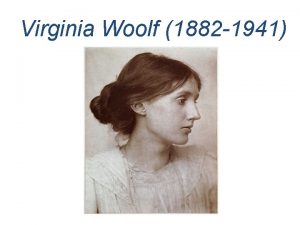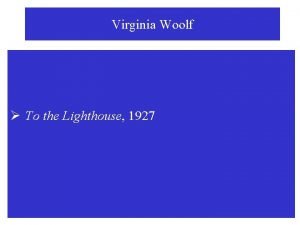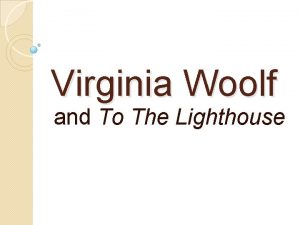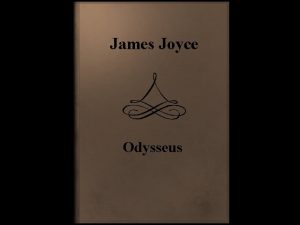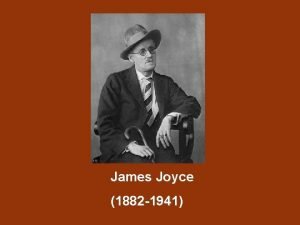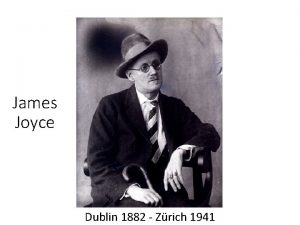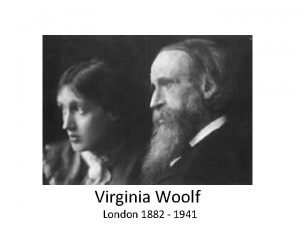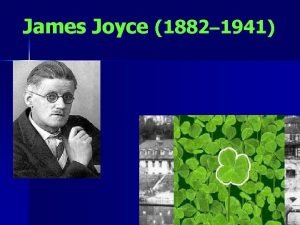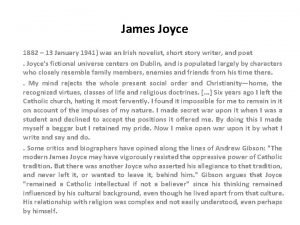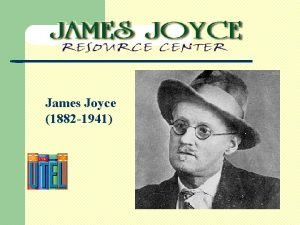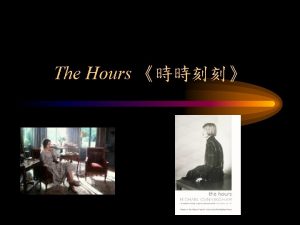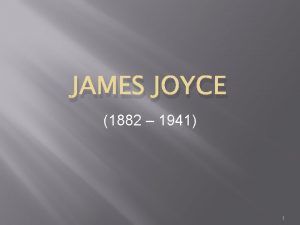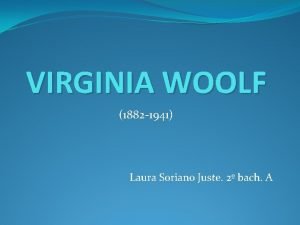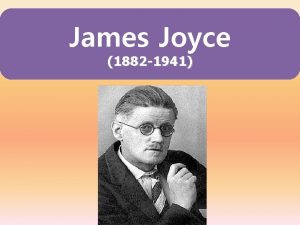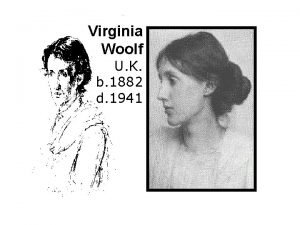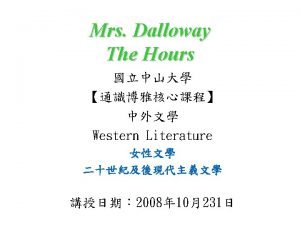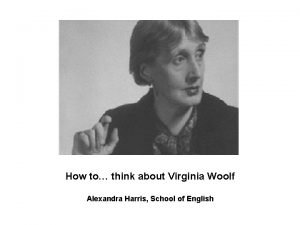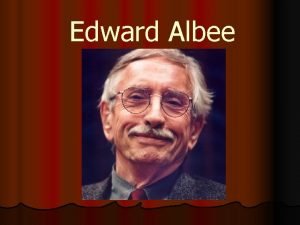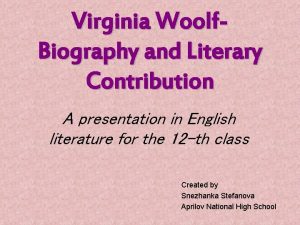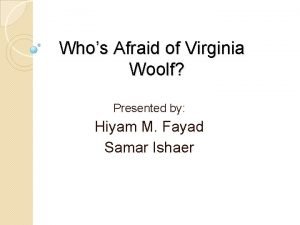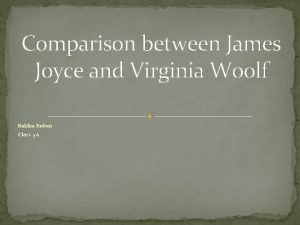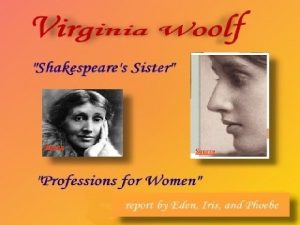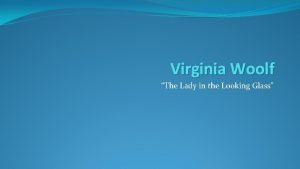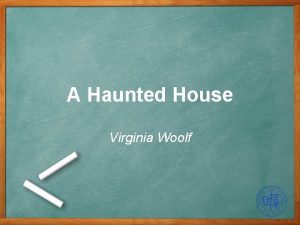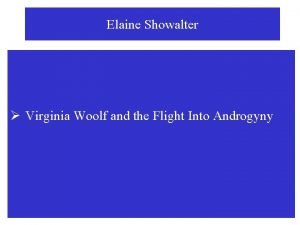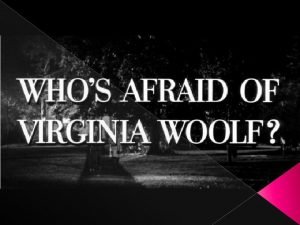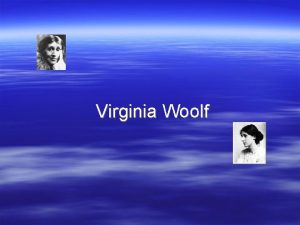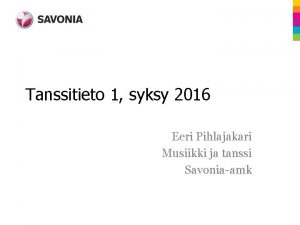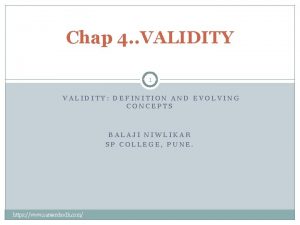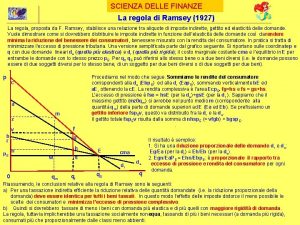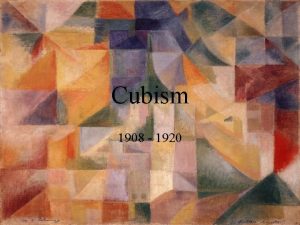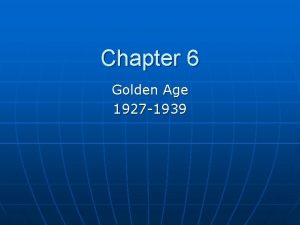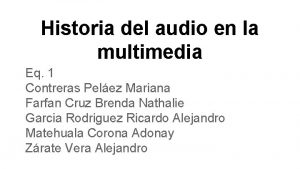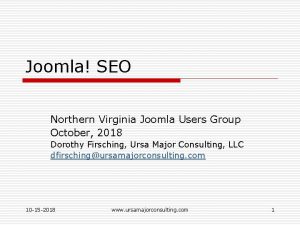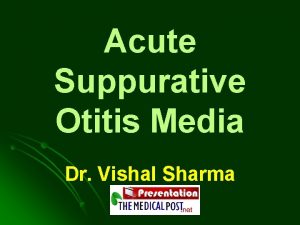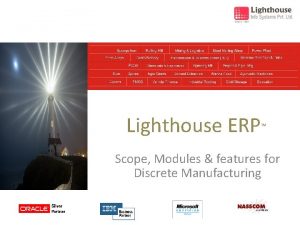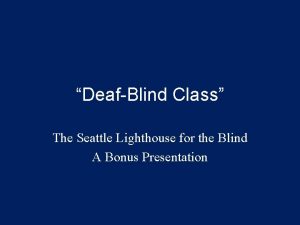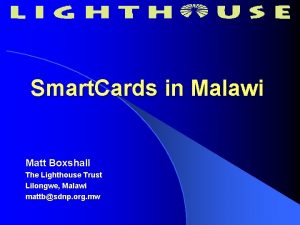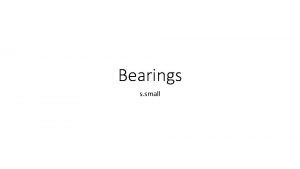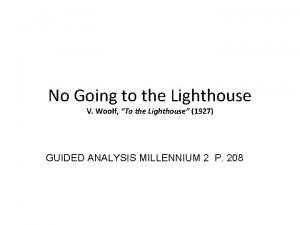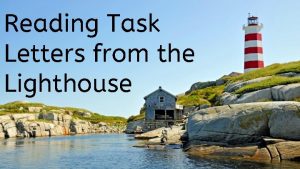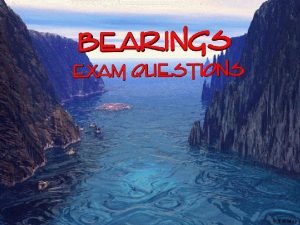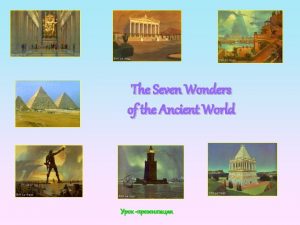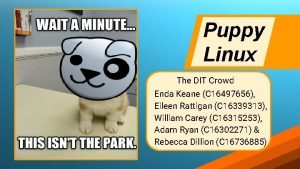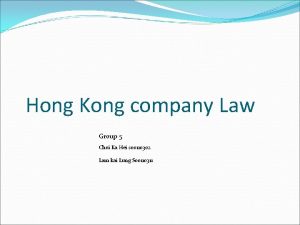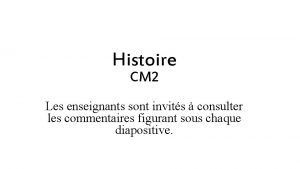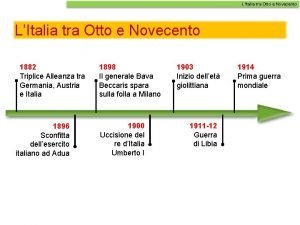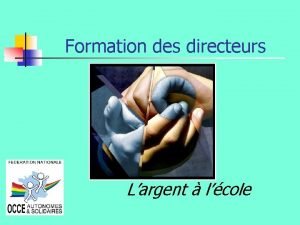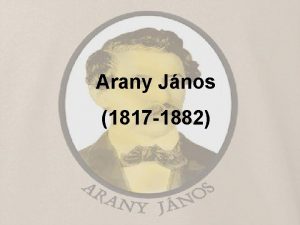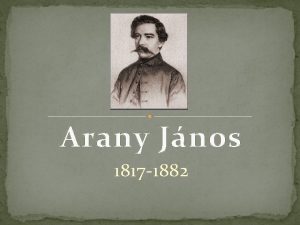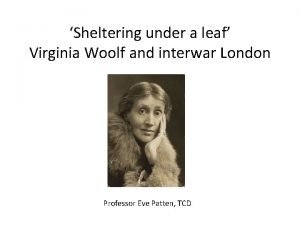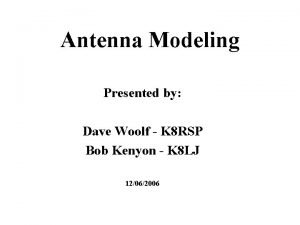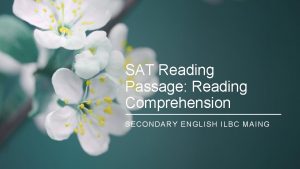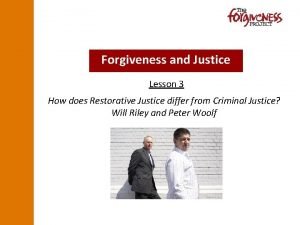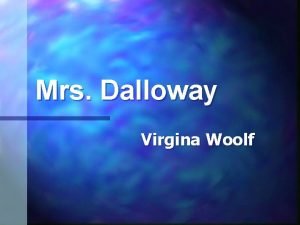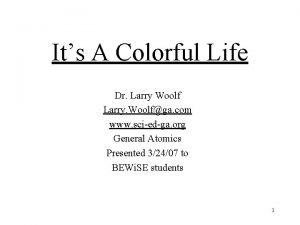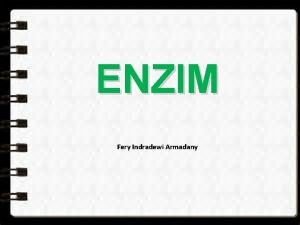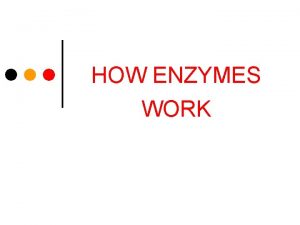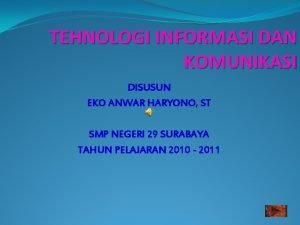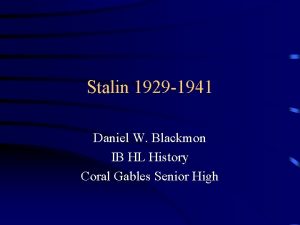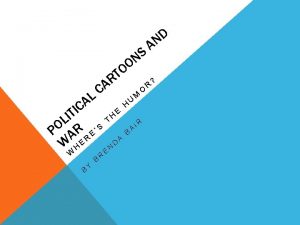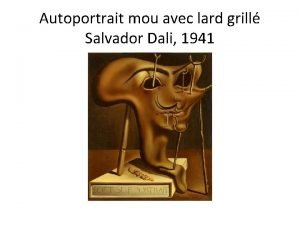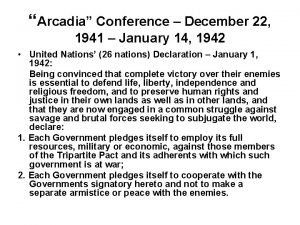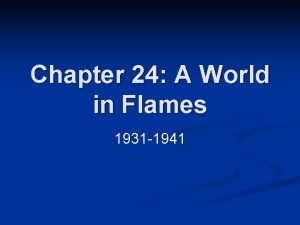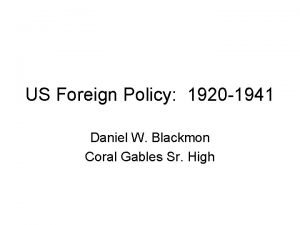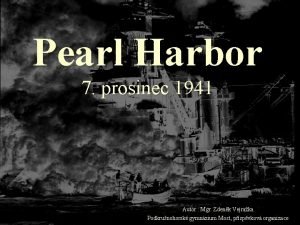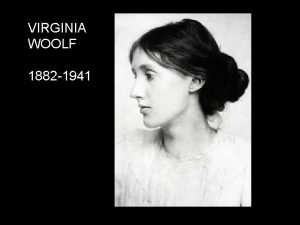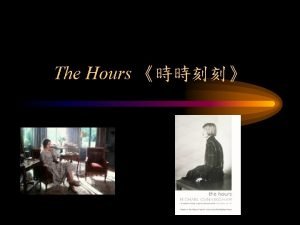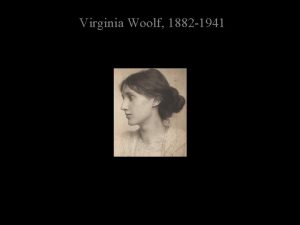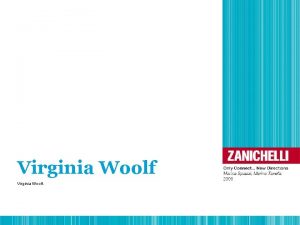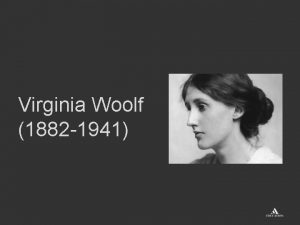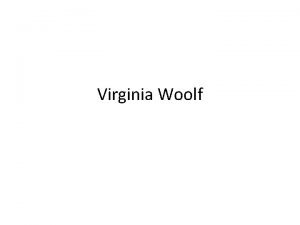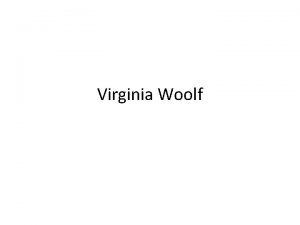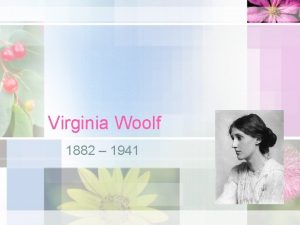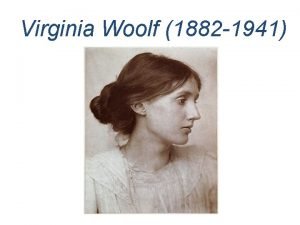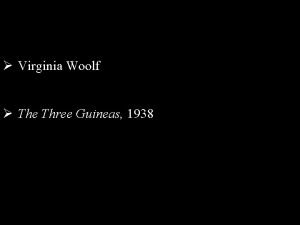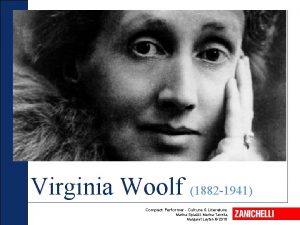Virginia Woolf To the Lighthouse 1927 1882 1941








































![Virginia Woolf - To the Lighthouse Ø Woolf stated that “[…] woman's writing is Virginia Woolf - To the Lighthouse Ø Woolf stated that “[…] woman's writing is](https://slidetodoc.com/presentation_image_h/17976b2c08c817b49a026fad952c016f/image-41.jpg)










































- Slides: 83

Virginia Woolf Ø To the Lighthouse, 1927

1882 -1941

Godrevy Lighthouse

Virginia Woolf - To the Lighthouse Ø The Characters Ø Mrs. Ramsay is the loving and hospitable wife of Mr. Ramsay. She is highly domestic, focusing on her roles as mother and wife. She deeply admires her husband, although she cannot tell him that she loves him. She is responsible and strong, but she dies unexpectedly in her fifties.

Virginia Woolf - To the Lighthouse Ø Mr. Ramsay is dominated by rationality and scientific reason. He is in search of truth and greatness, and he fears that he is rather inadequate for not achieving his aims. Neither affectionate nor sentimental, he nevertheless inspires admiration in his wife, although she becomes irritated with his insensitivity.

Virginia Woolf - To the Lighthouse Ø Lily Briscoe Ø A young, unmarried painter friend of the Ramsays. She is extremely fond of Mrs. Ramsay and feels a profound sense of emptiness after she dies. She begins a portrait at the beginning of the novel that she cannot finish until the end, ten years later, when the Ramsays reach the Lighthouse. Ø James Ramsay Ø The youngest Ramsay child, James is six years old when the book begins. He adores his mother and is violently resentful of his father. He enjoys cutting images out of magazines and wants desperately to go to

Virginia Woolf - To the Lighthouse Ø Jasper Ramsay Ø One of the Ramsay sons. He enjoys shooting birds, which disturbs his mother, while Mr. Ramsay thinks that doing so is normal for a boy of his age. Ø Roger Ramsay Ø One of the Ramsay sons, Roger is adventurous and most similar to his sister, Nancy. Ø Prue Ramsay Ø Prue is the oldest of the Ramsays' daughters, and her mother expects her to be an exceptional beauty when

Virginia Woolf - To the Lighthouse Ø Rose Ramsay Ø One of the Ramsay daughters, Rose is aesthetically inclined. She enjoys making beautiful arrangements and choosing her mother's jewelry. Ø Nancy Ramsay Ø One of the Ramsay daughters, Nancy is adventurous and independent, secretly hoping for a life much different from her mother's. She does not seem domestic. She accompanies Paul Rayley and Minta Doyle on their engagement walk to the beach.

Virginia Woolf - To the Lighthouse Ø Cam Ramsay Ø Cam is the Ramsays' youngest daughter. She is an energetic and mischievous child, and Mrs. Ramsay laments that she must grow up and suffer. Cam sails with James and Mr. Ramsay to the Lighthouse in the final section of the novel. Ø Andrew Ramsay Ø The oldest son of the Ramsays, Andrew accompanies Paul Rayley and Minta Doyle on their engagement walk to the beach. He is a gifted mathematician, but he dies fighting in World War I.

Virginia Woolf - To the Lighthouse Ø Paul Rayley Ø A young friend of the Ramsays, visiting them at their summer home, Paul proposes to Minta Doyle on the beach as Mrs. Ramsay wished. Ø Minta Doyle Ø A young woman visiting the Ramsays at their summer home, Minta accepts Paul Rayley's marriage proposal.

Virginia Woolf - To the Lighthouse Ø Charles Tansley Ø An odious athiest whom none of the Ramsays particularly like, Charles is one of Mr. Ramsay's philosophy pupils. He is insulting and chauvinistic, trying to discourage Lily from painting. He is often concerned with the affairs and status of others and is very self-centered. He finds Mrs. Ramsay quite beautiful and is proud to be seen walking with her.

Virginia Woolf - To the Lighthouse Ø William Bankes Ø An old friend of the Ramsays visiting their summer home, William is a botanist. He is a gentle man of about 60, and Mrs. Ramsay hopes that he will marry Lily Briscoe--making thinly veiled attempts at getting them together. He and Lily remain close friends, and she trusts him deeply. Ø Augustus Carmichael Ø An unhappy poet who takes opium and achieves little success until after World War I. Because of his controlling wife, he is not fond of Mrs. Ramsay.

Virginia Woolf - To the Lighthouse Ø Mrs. Mc. Nab Ø The witless and leering housekeeper, Mrs. Mc. Nab is asked to enter the Ramsays' home after years of disuse to open the windows and dust the bedrooms. Ø Macalister Ø A fisherman friend who accompanies the Ramsays to the Lighthouse. Ø Macalister's boy Ø The fisherman's son who rows the Ramsays to the Lighthouse.

Virginia Woolf - To the Lighthouse Ø Badger Ø The Ramsays' toothless dog. Ø Kennedy Ø The Ramsays' lazy gardener. Ø Mrs. Bast Ø A woman who comes to help Mrs. Mc. Nab clean the Ramsays' summer home during the "Time Passes" interlude.

Virginia Woolf - To the Lighthouse Ø George Bast Ø Mrs. Bast's son, who also helps clean the Ramsays' house. Ø Mrs. Beckwith Ø A visitor to the Ramsay house at the Lighthouse. Ø END

Virginia Woolf - To the Lighthouse Ø To the Lighthouse is a highly experimental novel, whose surface structure is divided in three very uneven parts: the first (The window, divided in 19 sections ), the longest, contains 130 pages, the second 22 (Time passes, divided in 10 sections), and the third 67 (To the Lighthouse, divided in 13 sections). Ø The form of the novel has been the subject of much heated debate. Ø However, when analysing the structure of the novel one can realize the reasons behind this apparently odd structure.

Virginia Woolf - To the Lighthouse Ø The reader, even an experience one, is confronted at least with five obstacles: Ø Ø 1) the normal horizon of expectations is broken, since nothing seems to happen. Ø We travel from section to section without understanding what is really being narrated, in almost a rhizomatic structure: the lack of a “story” constitute in itself a major difficulty. Ø

Virginia Woolf - To the Lighthouse Ø 2) the lack of a central narrative voice gives rise to a multiplicity of voices, to a very polyphonical and dialogical narration (Bahktine). Ø This contributes to confuse further the reader who is unable to determine who is narrating. Ø Ø 3) the back and forth of the narrative voice between external and internal narrative passages, reveals a narration that seems to be very little related to external factor that normally triggers a narration, but rather is initiated by pure internal factors.

Virginia Woolf - To the Lighthouse Ø 4) fourthly, how can this text be considered as making a statement about the condition and lives of women? Ø The subtleness of this aspect is indeed one that requires special attention. Ø

Virginia Woolf - To the Lighthouse Ø 5) Finally, the form of the novel. Ø This is a topic that has not received, in my estimation, an adequate attention, and it is the form of the novel which constitutes, in my view, the most enduring and fundamental contribution that Woolf made to world literature and women’s literature in particular.

Virginia Woolf - To the Lighthouse Ø In fact, her articles in Women and writing (- Michelle Barrett, Ed. , 1979) was already a monumental achievement and clearly explains the condition of women aspiring to become writers. Ø It is obvious that her thinking on these issues are not entirely reflected in her writing. Ø In light of this, one must considered Woolf social background. She is a product of the Victorian age, although a rebellious one.

Virginia Woolf - To the Lighthouse Ø She was highly educated, and her father, the wellknown editor, Leslie Stephen had a lot to do with her education. Ø But at the same time, she was shaped as a woman into the typical feminine roles assigned to women at that time by her mother, Julia Stephen. Ø Although Woolf could never quite abandon totally that education, she indeed did clearly rebel against it.

Virginia Woolf - To the Lighthouse Ø I propose, then, to establish a dialogue between Women and Writing (1979 [1882 -1941]) and to follow two threads in To the Lighthouse (1991 [1927] in order to underscore and understand Woolf’s position vis-à-vis patriarchy and women’s place in it and the issue of writing. Ø In Women and Fiction Woolf provides a very revealing background regarding women within patriarchal society and writing: Ø Ø The most superficial inquiry into women’s writing instantly raises a host of questions.

Virginia Woolf - To the Lighthouse Ø Why was there no continuous writing done by women before the eighteenth century? Why did they then write almost as habitually as men, and in the course of that writing produce, one after another, some of the classic of English fiction? (1979: 43) Ø […] Ø The history of England is the history of the male line, not of the female. Of our fathers we know always some fact, some distinction. They were soldiers or they were sailors; they filled that office or they made that law. But of our mothers, our grandmothers, our greatgrandmothers, what remains? Nothing but a tradition.

Virginia Woolf - To the Lighthouse Ø One was beautiful; one was red haired; one was kissed by a Queen. We know nothing of them except their names and the dates of their marriages and the number of children they bore. (1979: 44) Ø These are some of the reason why women do not write: they have been deprived of a whole range of experiences that they cannot express since they have no access to them. Ø

Virginia Woolf - To the Lighthouse Ø But in England in the sixteenth century, when the dramatists and poets were most active, the women were dumb. Elizabethan literature is exclusively masculine. Then, at the end of the eighteenth century and in the beginning of the nineteenth, we find women again writing — this time in England — with extraordinary frequency and success. (1979: 45) Ø

Virginia Woolf - To the Lighthouse Ø Again, with memoirs and letters to help us, we are beginning to understand how abnormal is the effort needed to produce a work of art, and what shelter and what support the mind of the artist requires. (1979: 45)

Virginia Woolf - To the Lighthouse Ø It is the patriarchal Law that suppresses any possibility to expand their potential and to become autonomous beings. Ø They lack the essential conditions of possibilities to be able to engage in writing. Ø In “Professions for Women” Woolf narrates the now famous story of ‘The Angel in the House’, who whispers to Woolf how to hide her own identity and her writing, Ø

Virginia Woolf - To the Lighthouse Ø 'My dear, you are a young woman. You are writing about a book that has been written by a man. Be sympathetic; be tender; flatter; deceive; use all the arts and wiles of our sex. Never let anybody guess that you have a mind of your own. Above all, be pure. ' (1979: 59) Ø

Virginia Woolf - To the Lighthouse Ø And Woolf makes some remarkable comments: Ø Ø And all these questions, according to the Angel of the House, cannot be dealt with freely and openly by women; they must charm, they must conciliate, they must — to put it bluntly — tell lies if they are to succeed. (1976: 59 60) Ø […]

Virginia Woolf - To the Lighthouse Ø The Angel was dead; what then remained? You may say that what remained was a simple and common object — a young woman in a bedroom with an inkpot. In other words, now that she had rid herself of falsehood, that young woman had only to be herself. Ah, but what is 'herself'? I mean, what is a woman? I assure you, I do not know. I do not believe that you know. I do not believe that anybody can know until she has expressed herself in all the arts and professions open to human skill. (1976: 59 -60)

Virginia Woolf - To the Lighthouse Ø What is remarkable here are two things: Ø First, The Angel of the House is nothing but repression: Ø the matriarchal repression which attempts to bury any imagination of the girl.

Virginia Woolf - To the Lighthouse Ø This is what Luce Irigaray call a form of mimicry: Ø Ø Women’s social inferiority is reinforced and complicated by the fact that woman does not have access to language, except through recourse to “masculine” systems of representation which disappropriate her from her relation to herself and to other women. (1985: 85)

Virginia Woolf - To the Lighthouse Ø Secondly, she also raises a question which will be much debated by post-feminists American women scholars and by the French women scholars such as Hélène Cixous what is a woman? Ø It is remarkable and visionary that Woolf would ask such a question ant the very beginning of the XXth.

Virginia Woolf - To the Lighthouse Ø Cixous once stated that, Ø We are unable to inscribe or write them since we don’t know who we are, something we never consider since we always take ourselves for ourselves; and from this point on we no longer know anything. I’ll tell you frankly that I haven’t the faintest idea who I am, but at least I don’t know. I am not the other able to perceive me. I know some things about myself. I know who I’m not, I believe. (1994: 200)

Virginia Woolf - To the Lighthouse Ø How can women write if they have been prevented to have access to a whole array of experiences including their own emotional and psychological experiences? Ø The only space left is the inwardness of their own feelings and passions, but this, in turn, are seriously censored. Woolf is indeed mindful of this reality when she states that, Ø Ø To speak without figure she had thought of something, something about the body, about the passions which it was unfitting for her as a woman to say. Men, her reason told her, would be shocked.

Virginia Woolf - To the Lighthouse Ø Not only women are prevented to express their most intimate experiences, thoughts, and feelings, but on the other have they are subject to a appalling double standard: males writers have license to publish almost anything free of a major censorship. Ø My intention in quoting extensively these various articles by Woolf regarding women and fiction, is to demonstrate how committed she was to women’s freedoms and also how enlighten she was about this issues, demonstrating in addition how ahead of her time she was pertaining women issues.

Virginia Woolf - To the Lighthouse Ø When Showalter wrote her scathing and incensed diatribe against Woolf in her book Literature of Their Own: British Women Novelists from Brontë to Lessing (1977) in a chapter entitled “Virginia Woolf and the Flight Into Androgyny”, she completely missed read Woolf. Ø In fact, she makes a mockery of everything Woolf wrote in Women and Writing, failing not only to see her strong commitment to “feminism” (the word did not exist then), but also was she was attempting to do pertaining the art of the novel.

Virginia Woolf - To the Lighthouse Ø There, her goal was “to demystify the legend of Virginia Woolf “ (1977: 264), and so she goes: Ø Ø Androgyny was the myth that helped her evade confrontation with her own painful femaleness and enabled her to choke and repress her anger and ambition. (1976: 264) Ø […] Ø Even in the moment of expressing feminist conflict, Woolf wanted to transcend it. Her wish for experience was really a wish to forget experience. Ø […]

Virginia Woolf - To the Lighthouse Ø In the 1920 s, as her fiction moved away from realism, her criticism and her theoretical prose moved away from a troubled feminism toward a concept of serene androgyny.
![Virginia Woolf To the Lighthouse Ø Woolf stated that womans writing is Virginia Woolf - To the Lighthouse Ø Woolf stated that “[…] woman's writing is](https://slidetodoc.com/presentation_image_h/17976b2c08c817b49a026fad952c016f/image-41.jpg)
Virginia Woolf - To the Lighthouse Ø Woolf stated that “[…] woman's writing is always feminine; it cannot help being feminine: the only difficulty lies in defining what we mean by feminine” (1976: 264). Ø What Woolf is referring to here is that women such as the Brontës, Austen or Eliot wrote from a position of “indignation” and “anger”, and art, the art of the novel, for Woolf, cannot be simply a vehicle for expressing the injustices of patriarchal society:

Virginia Woolf - To the Lighthouse Ø The desire to plead some personal cause or to make a character the mouthpiece of some personal discontent or grievance always has a distressing effect, as if the spot at which the reader's attention is directed were suddenly two fold instead of single. (1976: 47) Ø Ø For Woolf, the real change a woman writer should bring into literature is the search for new forms of expression, for a new form of the novel, not one that follows the realism of male writing.

Virginia Woolf - To the Lighthouse Ø And this is what Showalter is demanding from Woolf, to write realist novels like men. Ø Woolf recognised early on that women should write differently and find their own voice and forms of expressions. Ø She considered this to be by far and drastically more transformational than speaking out of hatred or anger. Ø This is clearly reflected in a passage from “Women Novelists”:

Virginia Woolf - To the Lighthouse Ø And finally (as regards this review at least) there raises for consideration the very difficult question of the difference between the man’s and the woman’s view of what constitutes the importance of any subject. Ø From this spring not only marked differences of plot and incident, but infinite differences in selection, method and style. (1976: 71)

Virginia Woolf - To the Lighthouse Ø For Cixous, in The Newly Born Woman, writing is a liberating a activity done of passage, of inscribing your own voice: Ø Ø Writing is the passageway, the entrance, the exit, the dwelling place of the other in me-the other that I am and am not, that I don’t know how to be, but I feel passing, that makes me live that tears me apart, disturbs me, changes me, who? a feminine one, a masculine one, some? . several, some unknown, which is indeed what gives me the desire to know and from which all life soars. (1986: 85 -86)

Virginia Woolf - To the Lighthouse Ø And in “The Laugh of the Medusa” goes back to this topic: Ø Ø I shall speak about women's writing: about what it will do. Woman must write herself: must write about women and bring women to writing, from which they have been driven away as violently as from their bodies — for the same reasons, by the same law, with the same fatal goal. Woman must put herself into the text — as into the world and into history — by her own movement. (1981: 245) Ø […]

Virginia Woolf - To the Lighthouse Ø If we now turn to one of the most achieved novel by Woolf, To the Lighthouse, we can find many subtle passages underscoring women’s place under patriarchal society.

Virginia Woolf - To the Lighthouse Ø And it was then too, in that chill and windy way, as she began to paint, that there forced themselves upon her other things, her own inadequacy, her insignificance, keeping house for her father off the Brompton Road, and had much ado to control her impulse to fling herself (thank Heaven she had always resisted so far) at Mrs. Ramsay's knee and say to her — but what could one say to her? 'I'm in love with you? ' No, that was not true. 'I'm in love with this all', waving her hand at the hedge, at the house, at the children? It was absurd, it was impossible. One could not say what one meant. (1991: 14) Ø

Virginia Woolf - To the Lighthouse Ø Woolf describes how a woman artist, a painter, an art belonging to men, feels. Ø Woolf describes the sense of inadequacy, of practicing an art that seemingly does not belong to her. Ø This is follow by a comment as Lily supresses her impulse and desire to be free.

Virginia Woolf - To the Lighthouse Ø Regarding how Woolf saw men, there is a profound description of her own husband, Rhoderick Ramsey: Ø Ø He shivered: he quivered. All his vanity, all his satisfaction in his own splendour, riding fell as a thunderbolt, fierce as a hawk a the head of his men through the valley of death, had been shattered, destroyed. Stormed at by shot of death and shell, boldly we rode and well, flashed through the valley of death, volleyed and thundered – straight into Lily Briscose and William Bankes. He quivered, he shivered. (1991: 36) Ø

Virginia Woolf - To the Lighthouse Ø There are many passages like these ones (41, 43, 45, 69, 131, 132) which clearly reveal Woolf’s position regarding the woman condition at the time of her creative activity, and men’s self-aggrandising. Ø

Virginia Woolf - To the Lighthouse Ø 5) In search of a new language: the form of the Novel Ø Ø It is imperative to place Woolf in the cultural and literary space in which she lived and wrote. Ø That place is cultural and literary Modernity. Ø In Woolf’s writing there is a fundamental search: that of a new language “style”, and a new form.

Virginia Woolf - To the Lighthouse Ø 5) In search of a new language: the form of the Novel Ø Ø Her experiments with the form of the novel are congruent with literary Modernity in terms of its fragmentation, both of the narrative voice (stream of consciousness and interior monologue, direct and indirect), and the structure itself. Ø

Virginia Woolf - To the Lighthouse Ø 5) In search of a new language: the form of the Novel Ø Ø This meant moving drastically away from realism, which was still the cannon and particularly for women writers such as the Brontë’s and Jane Austen, which in fact never dare to experiment with form, language and narrativity. Ø And this is exactly what Woolf does, and this is what Showalter totally failed to understand, in fact she does not understand Modernity, because if she did she could not have made the following statement:

Virginia Woolf - To the Lighthouse Ø 5) In search of a new language: the form of the Novel Ø Ø […] “The woman writer is urged to be as `Woolfian' as possible, ” ac cording to Joyce Carol Oates that is, to be subjective, and yet to transcend her femaleness, to write exquisitely about inner space and leave the big messy brawling novels to men. Ø A similar idealization and mystification of Woolf's life style is extending her sphere of historical influence to per sonal relationships. (1977: 265) Ø

Virginia Woolf - To the Lighthouse Ø 5) In search of a new language: the form of the Novel Ø Ø Introspection, inwardness and outmost subjectivity was central to Modernity, not only in literature – think of Joyce or Proust- but in all the arts – as in surrealism (Chagall, Dalí Mirò). Ø The subconscious and the unconscious are central to modern narration. Ø So Woolf was only working within the new paradigm in narrative, however, she went even

Ø 1886 -1950 Ø Modernidad 1889 -1925 1925 -1950 Ø Introducción de Paradigmas Ciencia Normal Fin de la modernidad 1950 -1960


William Etty, Woman Asleep 1828 -30

Dali, Invisible Sleeping Woman, horse, lion 1930

Pablo Picasso Les Demoiselles d’Avignon 1907

Braque: The Cup - 1911

Marc Chagall Birthday, 1915

Joan Miró The Hunter, 1923 -1924

Salvador Dalí The Persistence of Memory, 1931

Wassily Kandinsky Painting No. 201 1914

Virginia Woolf - To the Lighthouse Ø 5) In search of a new language: the form of the Novel Ø Ø she created a “style”, a form and a language which was entirely feminine. Ø No women writer had done that before Woolf, and to criticise her on this bases amounts simply to attack her very writing project.

Virginia Woolf - To the Lighthouse Ø 5) In search of a new language: the form of the Novel Ø Ø In her writing we find Freud in terms of the interior monologues, Bergson and la durée, a new sensation of time so prevalent To the Lighthouse, fragmentation and discontinuity as in quantum physics, and the clear suspicion of language and its limits; its incapacity of full expression.

ØEpistemological Foundations ØFragmentation/discontinuity ØE=mc 2 Einstein and Planck: Physis and Quantum Theory ØBergson, La durée and Time ØFreud: Memory and the Unconscious: Psychoanalysis y Sub-conscious: The Stream of Consciousness

Virginia Woolf - To the Lighthouse Ø 5) In search of a new language: the form of the Novel Ø Ø Regarding some of these points, Maria Aparecida de Oliveira states: Ø Ø The writing method of Virginia Woolf besides being a technique is also related to reality, a fragmented reality with many narrative points of view.

Virginia Woolf - To the Lighthouse Ø 5) In search of a new language: the form of the Novel Ø Ø She introduces consciously an experimental narrative by manipulating language and the so called literary genres and she alters the very form of the novel, as is revealed in the following passage: Ø Ø But while I try to write, I am making up To the Lighthouse – the sea is to be heard all through it. I have an idea that I will invent a new name for my books to supplant “novel”. A new ………by Virginia Woolf. But what? Elegy. (Woolf, 1953: 80)

Virginia Woolf - To the Lighthouse Ø 5) In search of a new language: the form of the Novel Ø Ø In To The Lighthouse, Woolf was fully aware to be blurring the differences and borders between genres, and she was also aware that there was not a name for the type of fictions she was proposing to write: a lyrical prose, an “elegy” as she called To the Lighthouse. Ø Ø

Virginia Woolf - To the Lighthouse Ø 5) In search of a new language: the form of the Novel Ø Ø We shall be forced to invent new names for the different books which masquerade under this one heading. Ø And it is possible that there will be among the so called novels one which we shall scarcely know how to christen. It will be written in prose, but in prose which has many of the characteristics of poetry. (WOOLF, 1994, p. 435)

Virginia Woolf - To the Lighthouse Ø 5) In search of a new language: the form of the Novel Ø Ø In the very writing we notice these elements of lyricism, suche as rythm, aliterations, repetitions, etc. Ø Ø She uses painting, namely that of Lily Briscoe, which questions the limits of representation through language.

Virginia Woolf - To the Lighthouse Ø 5) In search of a new language: the form of the Novel Ø Ø One central element of her experimental writing, is the concentration on a fragment, namely a dinner party or an image o a fragment from the past, which is then expanded in a stretch of narrative, as is the case in the stocking and James fragment. Ø Ø All of this narrated in an interior indirect monologue which jumps from here to there and back, full of ellipsis, breaks, parenthesis, etc.

Virginia Woolf - To the Lighthouse Ø 5) In search of a new language: the form of the Novel Ø Ø In the first drafts To the Lighthouse, Woolf wished to demonstrate in three chapters the following situation: Ø in the first chapter, The Window, father, mother and children in the garden, Ø in the’ second, Times passes, death, and Ø in the third, The Lighthouse, the trip to the Lighthouse.

Virginia Woolf - To the Lighthouse Ø 5) In search of a new language: the form of the Novel Ø Ø In the first chapter Mrs. Ramsey is seating at the windowsill, which is, in turn, a metaphor of her mind in order to transmit their thoughts. Ø

Virginia Woolf - To the Lighthouse Ø 5) In search of a new language: the form of the Novel Ø De Toro Ø Ø Although the ‘events’ takes place within one day, in fact few hours, the chapter is the longest precisely due to the indirect interior monologue, and our experienced time, that is, the real time is infinitely longer than the ‘events’. We face a Bergsonian time, la durée. Ø

Virginia Woolf - To the Lighthouse Ø 5) Novel In search of a new language: the form of the Ø De Oliveira Ø he second chapter, Time Passes, time is encapsulate in 10 years which marks the passing of time by the very absence of Mrs. Ramsey who is now dead, the deterioration of the house. Ø Although the period is long, the chapter is the shortest of the novel and we have a quick sense of time.

Virginia Woolf - To the Lighthouse Ø 5) Novel In search of a new language: the form of the Ø We also learned that the oldest daughter, Prue, died giving birth and her Oldest son, Andrew died during the First World War. Ø However, this information it is not transmitted as part of the narration but in short paragraphs in parenthesis: Ø

Virginia Woolf - To the Lighthouse Ø 5) Novel In search of a new language: the form of the Ø [Mr. Ramsey stumbling along a passage stretched his arms out one dark morning, but, Mrs. Ramsey having died rather suddenly the night before, he stretched his arms out. They remained empty] 140 Ø Ø During the last chapter, some of the guests have returned to the house to spend a last Summer: Lily and Mr. Carmichael, Mr. Ramsey, her daughter Cam and his son James. Ø

Virginia Woolf - To the Lighthouse Ø 5) Novel In search of a new language: the form of the Ø In this chapter there are two narrative levels: Ø Ø One level describes the painting process of Lily Briscoe, Ø and the other the actual trip to the Lighthouse taken by Mr. Ramsey, James and Cam. Ø And the return of the travelers to the house coincides with the finishing of Lily’s painting.

Virginia Woolf - To the Lighthouse Ø 5) Novel In search of a new language: the form of the Ø Thus, the circularity of the text is complete: it began with a painting that remains unfinished until the last chapter. Ø END
 Tunneling technique woolf
Tunneling technique woolf Virginia woolf writing style
Virginia woolf writing style To the lighthouse virgina woolf
To the lighthouse virgina woolf štěpán dedalus
štěpán dedalus 1941-1882
1941-1882 1941-1882
1941-1882 1941-1882
1941-1882 1941-1882
1941-1882 1941-1882
1941-1882 1941-1882
1941-1882 1941-1882
1941-1882 Mrs dalloway summary
Mrs dalloway summary 1882-1941
1882-1941 1941-1882
1941-1882 Stream of consciousness literature
Stream of consciousness literature 1941-1882
1941-1882 Introducing james joyce
Introducing james joyce 1941-1882
1941-1882 1941
1941 Alexandra harris virginia woolf
Alexandra harris virginia woolf Who's afraid of virginia woolf themes
Who's afraid of virginia woolf themes Virginia woolf contributions
Virginia woolf contributions Who's afraid of virginia woolf themes
Who's afraid of virginia woolf themes Differences between joyce and woolf
Differences between joyce and woolf Virginia woolf family tree
Virginia woolf family tree Who is the narrator in the lady in the looking glass
Who is the narrator in the lady in the looking glass Haunted house outlines
Haunted house outlines Virginia woolf
Virginia woolf Who's afraid of virginia woolf as an absurd play
Who's afraid of virginia woolf as an absurd play Virginia woolf characteristics
Virginia woolf characteristics Tanssija 1877-1927
Tanssija 1877-1927 Kelly 1927 validity
Kelly 1927 validity Guerra civil china
Guerra civil china Ramsey 1927
Ramsey 1927 Cubism (1908-1920)
Cubism (1908-1920) Golden age of aviation 1927-1939
Golden age of aviation 1927-1939 1950-1927
1950-1927 Northern virginia seo
Northern virginia seo Reservoir sign in asom
Reservoir sign in asom Lighthouse on the hillside
Lighthouse on the hillside Can i use this image
Can i use this image Light house erp
Light house erp Children's lighthouse sienna
Children's lighthouse sienna Lighthouse for the blind seattle
Lighthouse for the blind seattle Lighthouse malawi
Lighthouse malawi Lighthouse profiling
Lighthouse profiling A ship sails from harbour h on a bearing of 084
A ship sails from harbour h on a bearing of 084 Lighthouse kvarnholmen
Lighthouse kvarnholmen No going to the lighthouse
No going to the lighthouse Letters from the lighthouse code answer
Letters from the lighthouse code answer Lighthouse antenna
Lighthouse antenna Nanchester
Nanchester Collosus of rhodes
Collosus of rhodes Nyx keane
Nyx keane Map of nc coast
Map of nc coast Howard shore the fellowship reunited
Howard shore the fellowship reunited Re german date coffee co
Re german date coffee co Loi du 28 mars 1882
Loi du 28 mars 1882 1882 triplice alleanza
1882 triplice alleanza Loi du 28 mars 1882
Loi du 28 mars 1882 1817-1882
1817-1882 1817-1882
1817-1882 1817 1882
1817 1882 Georges braque le jour
Georges braque le jour Virginaia woolf
Virginaia woolf Dave woolf
Dave woolf Which reaction does akira most fear from chie?
Which reaction does akira most fear from chie? Peter woolf and will riley
Peter woolf and will riley Virgina woolf mrs dalloway
Virgina woolf mrs dalloway Larry woolf
Larry woolf Pengelompokan enzim
Pengelompokan enzim Persamaan hanes woolf
Persamaan hanes woolf Hanes woolf plot
Hanes woolf plot Kode kentongan
Kode kentongan 1978-1941
1978-1941 Nicolas weissberg
Nicolas weissberg Ho hum when he's finished pecking down
Ho hum when he's finished pecking down Di cavalcanti cinco moças de guaratinguetá
Di cavalcanti cinco moças de guaratinguetá Salvador dali 1941
Salvador dali 1941 1941
1941 Arcadia conference 1941
Arcadia conference 1941 A world in flames, 1931-1941
A world in flames, 1931-1941 1941
1941 Prosinec 1941
Prosinec 1941
